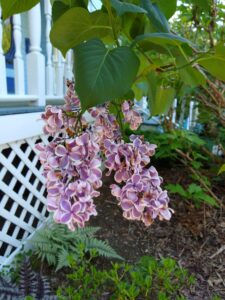 If I were to create an alphabetical summary of my garden’s current status, I would say, “L is for leggy lilacs looking lovely.”
If I were to create an alphabetical summary of my garden’s current status, I would say, “L is for leggy lilacs looking lovely.”
The “lovely’ part is the abundant, perfumed blooms. I grow three lilacs, all Syringa vulgaris, the most common type. Two have pale purple flowers and one, which is the newest, features deep purple petals edged in white. The “leggy” adjective refers to the fact that for the last two years I have forgotten to prune the shrubs after flowering. My lilacs and I both look better after a good haircut. I usually remember to make regular appointments to have my locks chapped. The lilacs are not so lucky.
Lilacs are generally good growers, and regularly attempt to become thickets by sprouting numerous root suckers. They also reach for the light, and in doing so become “leggy”, meaning that the branches reach for the heavens, and when flowering happens, all the panicles or flowerheads are at the tops of those branches. To keep lilacs in good shape, it is a good idea to remove the root suckers, and cut the branches back by at least one third after flowering. If the shrub is old, you should also take out the thickest, oldest branches to give the younger ones a fighting chance.
You can also do the annual pruning at the end of winter, but on the occasions when I have waited for that window of opportunity, it closed before I even remembered that it was open.
Even leggy lilacs will persist. When I visit Central New York State in the summer, I often see the familiar heart shaped leaves on bushes still hugging the sides of old Greek Revival farmhouses. Often, the people who planted them are long gone, and the farmhouses are sometimes abandoned and decayed. The only living things still thriving in some small corners of rural America are stalwart lilac bushes.
Deciduous lilacs–Syringa species and hybrids–like their springtime companions, forsythia, appear nondescript for fifty weeks every year. But for ten to fourteen days in mid spring, they are glorious, combining exquisite flowers, gorgeous color—including blue, purple, blue-purple, pink, white and creamy yellow–and ravishing fragrance. It’s enough to make you want to stage a festival to celebrate them, which is exactly happens in Rochester, New York, every year during the first week of May. Highland Park, a Frederick Law Olmsted-designed masterpiece, is home to Rochester’s formidable lilac collection, which draws thousands of visitors for the annual lilac celebration.
Rochester is a long way from the mountains of southeastern Europe, where Syringa vulgaris, the common lilac, originated. It was probably introduced to northern and Western Europe in the sixteenth century and it caught on. The species lacked have the showy panicles of modern varieties and hybrids, but its alluring fragrance attracted admirers. Considering the array of foul smells that confronted the average European at the time, it’s no wonder that lilacs grew popular.
North Americans probably first imported lilacs during the colonial period. Thomas Jefferson installed the shrubs at Shadwell, the plantation where he was born, and at Monticello. Clearly, he knew a good thing when he saw and smelled one. Ordinary gardeners followed suit.
Modern lilac lovers owe a significant debt to the Lemoine family of Nancy, France, who bred and sold plants from 1849 through 1960. Three generations of Lemoines were responsible for introducing over 200 cultivars, some of which of which are still obtainable. Victor Lemoine—1823-1911– the family patriarch, also gave the world the first double-flowered lilac, creating voluptuous doubles, like the purple ‘Alphonse Lavallée, introduced in 1885; the pinkish purple ‘Claude Bernard’, introduced in 1915; and ‘Miss Ellen Willmott’, a double white variety that made its debut in 1903. Even now, Lemoine lilacs are known collectively as “French lilacs,” in honor of the family’s contributions to lilac breeding.
But not all good lilacs originated in France. Father John L. Fiala was a mid twentieth century Catholic priest, educator and author of the book, Lilacs: The Genus Syringa. Father Fiala spent much of his life studying, growing and hybridizing lilacs, introducing over 50 named varieties, including the beautiful, ‘Wedgewood Blue’.
Before you invest in a new lilac, make sure you can provide it with the right conditions. The plants need either a dormant period–often about eight weeks–of winter temperatures at or below forty degrees Fahrenheit or, for those in warmer climates, several months of real or artificially induced drought in the summer. Full sun, is a must, as is well-drained soil. Pruning requirements, as I can attest, are easy to ignore, but will add up to more and better flowers.
Local nurseries and garden centers often stock several lilac varieties. If you want a more comprehensive selection, try Forestfarm, 14643 Watergap Rd, Williams, OR 97544, 541-846-7269; www.forestfarm.com. .
